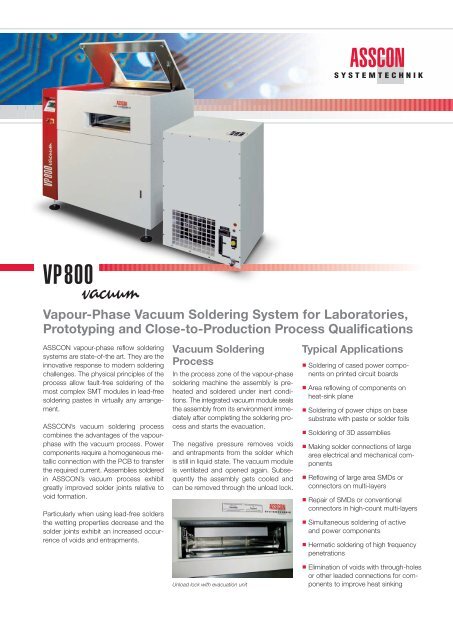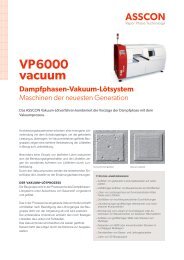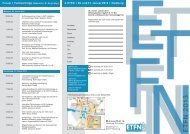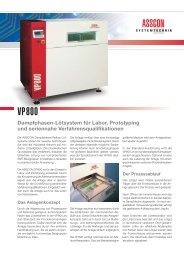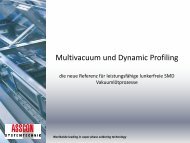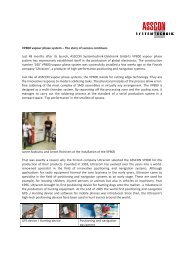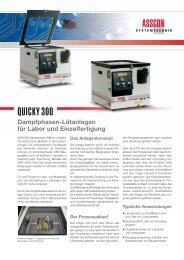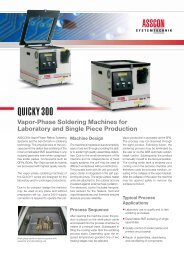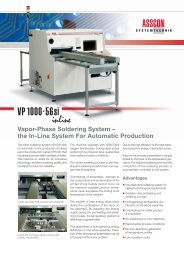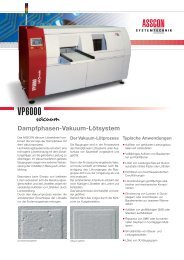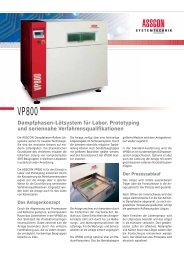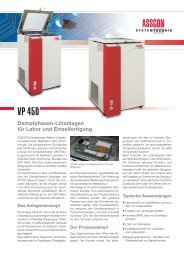Vapour-Phase Vacuum Soldering System for Laboratories - Amtest
Vapour-Phase Vacuum Soldering System for Laboratories - Amtest
Vapour-Phase Vacuum Soldering System for Laboratories - Amtest
You also want an ePaper? Increase the reach of your titles
YUMPU automatically turns print PDFs into web optimized ePapers that Google loves.
VP800<br />
<strong>Vapour</strong>-<strong>Phase</strong> <strong>Vacuum</strong> <strong>Soldering</strong> <strong>System</strong> <strong>for</strong> <strong>Laboratories</strong>,<br />
Prototyping and Close-to-Production Process Qualifications<br />
ASSCON vapour-phase reflow soldering<br />
systems are state-of-the art. They are the<br />
innovative response to modern soldering<br />
challenges. The physical principles of the<br />
process allow fault-free soldering of the<br />
most complex SMT modules in lead-free<br />
soldering pastes in virtually any arrangement.<br />
ASSCON’s vacuum soldering process<br />
combines the advantages of the vapourphase<br />
with the vacuum process. Power<br />
components require a homogeneous metallic<br />
connection with the PCB to transfer<br />
the required current. Assemblies soldered<br />
in ASSCON’s vacuum process exhibit<br />
greatly improved solder joints relative to<br />
void <strong>for</strong>mation.<br />
Particularly when using lead-free solders<br />
the wetting properties decrease and the<br />
solder joints exhibit an increased occurrence<br />
of voids and entrapments.<br />
<strong>Vacuum</strong> <strong>Soldering</strong><br />
Process<br />
In the process zone of the vapour-phase<br />
soldering machine the assembly is preheated<br />
and soldered under inert conditions.<br />
The integrated vacuum module seals<br />
the assembly from its environment immediately<br />
after completing the soldering process<br />
and starts the evacuation.<br />
The negative pressure removes voids<br />
and entrapments from the solder which<br />
is still in liquid state. The vacuum module<br />
is ventilated and opened again. Subsequently<br />
the assembly gets cooled and<br />
can be removed through the unload lock.<br />
Unload lock with evacuation unit<br />
Typical Applications<br />
<strong>Soldering</strong> of cased power components<br />
on printed circuit boards<br />
Area reflowing of components on<br />
heat-sink plane<br />
<strong>Soldering</strong> of power chips on base<br />
substrate with paste or solder foils<br />
<strong>Soldering</strong> of 3D assemblies<br />
Making solder connections of large<br />
area electrical and mechanical components<br />
Reflowing of large area SMDs or<br />
connectors on multi-layers<br />
Repair of SMDs or conventional<br />
connectors in high-count multi-layers<br />
Simultaneous soldering of active<br />
and power components<br />
Hermetic soldering of high frequency<br />
penetrations<br />
Elimination of voids with through-holes<br />
or other leaded connections <strong>for</strong> components<br />
to improve heat sinking
VP800·vacuum<br />
with technique unit<br />
Machine Conception<br />
As the processing zone is separated from<br />
the vacuum module and cooling zone, it is<br />
possible to apply the soldering process in<br />
the VP800·vacuum system to the standard<br />
achieved by current production lines<br />
in a compact environment. Here, the system<br />
especially stands out by virtue of its<br />
simple handling, enabling each user to<br />
solder high-quality modules fault-free.<br />
The vacuum module consists of the evacuation<br />
unit, which is mounted on cylinders<br />
and can be easily removed <strong>for</strong> maintenance.<br />
<strong>Vacuum</strong> pump, valves and sensors<br />
are installed in an monobloc technique<br />
unit, which is to be set up beside the reflow<br />
soldering system and contains also<br />
the cooling unit <strong>for</strong> the soldering system.<br />
Optionally, the VP800·vacuum can be<br />
equipped with a fluid filter system. The<br />
medium which is filtered at the start of<br />
the process is refed into the system cycle.<br />
Process Sequence<br />
Via the loading lock at the front, the solder<br />
piece is inserted into the system. The process<br />
is started. After the inner lock has<br />
opened, the soldering piece is lowered by<br />
an electric motor into the clearly defined<br />
Technical Data<br />
Evacuation unit<br />
Maximum solder piece <strong>for</strong>mat 320 x 300 mm<br />
Maximum solder piece height 55 mm<br />
Main voltage 400 V / 3 / PE / N -50 Hz<br />
Connected load reflow soldering unit 5,5 kW<br />
Connected load technique unit 3,0 kW<br />
Fluid filling quantity 15 kg<br />
vapour level. Depending on the selected<br />
temperature gradient, the solder piece is<br />
heated up to a predefined temperature.<br />
Upon reaching the soldering temperature,<br />
the soldering process is terminated<br />
and the solder piece is transferred to the<br />
evacuation unit. The vacuum process proceeds.<br />
After the vacuum process blowers<br />
grant an effective evaporation and cooling<br />
be<strong>for</strong>e the solder piece can be taken out<br />
of the unloading lock at the front. Termination<br />
of the process is indicated by an<br />
acoustic signal.<br />
Typical Applications<br />
Laboratory<br />
Prototyping, Small batch series<br />
Close-to-production process qualification<br />
Research & Development<br />
Training, University<br />
ASSCON<br />
<strong>System</strong>technik-Elektronik GmbH<br />
Messerschmittring 35<br />
D-86343 Königsbrunn<br />
VP800 VP1000 56<br />
VP800<br />
at a Glance:<br />
User-friendly reflow soldering<br />
system<br />
Effective vacuum unit<br />
Adjustable vacuum ensures ideal<br />
void-free solder joints<br />
Automatic fluid identification<br />
Continuously adjustable<br />
temperature gradient<br />
Oxygen-free preheating and<br />
soldering process<br />
Lead-free soldering pastes<br />
can be used without limitation<br />
Optional fluid filter system<br />
including pump<br />
°C<br />
TGC<br />
200<br />
Adjustable<br />
Range of<br />
150<br />
100<br />
Temperature<br />
Gradients<br />
50<br />
Temperature<br />
development<br />
0<br />
°C/sec.<br />
0 200 400 sec.<br />
Optimum process reliability<br />
through:<br />
ASB (automatic-solder-break),<br />
automatic detection of the<br />
terminated soldering process<br />
TGC (temperature-gradient-control),<br />
selectable temperature gradients<br />
in the preheating zone<br />
OPC (optical-process-control),<br />
visual process control<br />
Phone: +49 (0) 82 31/ 9 59 91-0<br />
Fax: +49 (0) 82 31/ 9 59 91-90<br />
e-mail: info@asscon.de<br />
http://www.asscon.de<br />
05/2009


